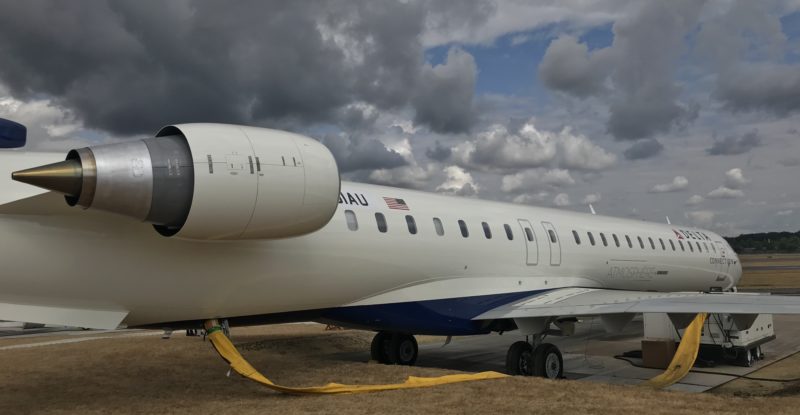A key partner on the Eutelsat OneWeb connectivity program, Hughes Network Systems has to date shipped over 5,000 enterprise-class electronically steerable antenna (ESA) terminals to facilitate the OneWeb Ku-band Low Earth Orbit (LEO) service.
Business and government customers can expect speeds of 195 Mbps down and 32 Mbps up, the EchoStar subsidiary says. Hughes also develops and manufactures the gateway electronics and core modules used in every terminal on the Eutelsat OneWeb LEO system.
But Hughes’ prominent position in this LEO ecosystem also sees the firm supporting the aviation market both as an antenna hardware provider and one of its global service distributors.
To wit, its aero ESA forms the basis of Gogo Business Aviation’s forthcoming OneWeb-powered Galileo BizAv IFC product, which is on track to start shipping HDX (half-duplex) terminals in the fourth quarter and FDX (full-duplex) terminals in the first half of 2025, according to Gogo. And Hughes, itself, will launch a version of the ESA next year in the commercial aviation space, supporting OneWeb LEO-specific service at airlines or acting as a LEO augment to any geostationary (GEO) IFC service.
As a OneWeb LEO service distribution partner, and a GEO satellite operator in its own right, Hughes can serve commercial aviation directly as an ISP or indeed in a partnership capacity.
We caught up with Reza Rasoulian, senior vice president of the Aviation Business Unit at Hughes, to get an update on the Germantown, Maryland-based firm’s OneWeb aero-specific activities, as well as its work to bring its Jupiter In-Flight GEO (geostationary satellite)-now focused Ka-band IFC product to Delta’s Boeing 717s and regional jets (with a path to Ka-band MEO and LEO service in the future.)
RGN: Gogo is now sharing specs (PDF available via download) around its HDX and FDX ESA hardware for BizAv, which is based on Hughes’ LEO ESA. Gogo says the former uses maximum power of 155W and the latter uses maximum power of 330W. Will Hughes’ ESA for the commercial aviation market use the same wattage (330W for full duplex)?
Rasoulian: As you likely know, the commercial aviation and business aviation Hughes LEO full duplex (FDX) are largely similar. Our commercial aviation variant is optimized for the commercial aviation sector and uses a fraction of the power of other ESAs in the market very low maximum power consumption consistent with the performance of the FDX. Through our careful design and engineering we are able to balance size, weight, and power of our entire shipset to deliver a lightweight and power efficient solution to airline customers.
RGN: Does Hughes still intend to ship ESA hardware for commercial aviation in the first half of 2025? Does Hughes intend to do any of its own flight-testing of the hardware, and if so, on what aircraft type? Will Hughes seek to own all the STCs for its LEO-based commercial aviation solution (or might it work with other parties in some instances)?
Rasoulian: Hughes black label ESAs for commercial aviation will be available in the first half of 2025. Our ESAs will be flying by the end of 2024, and Hughes will own the STCs for our commercial aviation solutions. Overall, Hughes will work with or through partnerships where it makes sense to deliver the best solution for airlines worldwide.
RGN: Given the strong performance of Eutelsat OneWeb LEO on the ground (195 Mbps down/32 Mbps up), what type of passenger experience should we expect onboard a narrowbody aircraft fitted with Hughes’ LEO-based solution for commercial aviation? What type of speeds?
Rasoulian: Passengers should expect a living-room like experience including low latency, high service availability, and throughput when using Hughes In-Flight Connectivity. Latency is arguably more impactful to the online experience than throughput alone. Cloud-based applications such as SharePoint, SAP, etc. are mission-critical to today’s business traveler — and those applications require the low latency enabled by LEO networks such as Eutelsat OneWeb.
End-to-end service availability is one of the qualities most valued by airlines and passengers alike. Hughes is designing that into our solutions from ‘day-1’. Service availability is optimized via Hughes aviation managed service enabled by data science, AI, ML which is critical to ensuring an amazing connectivity experience while flying. Hughes is focused on delivering a great experience to airlines and their passengers.
Airlines are not one-size-fits all, and throughputs must reflect their respective use-cases. As airlines around the world focus on a differentiated digital customer experience, the technology onboard must be flexible to meet those demands. Overall, Hughes is looking beyond just ‘one metric’ when we deploy our solutions.
RGN: Delta recently provided an update about its equipage of RJs and Boeing 717s with Hughes’ GEO-based IFC solution, saying the aircraft will come online “into 2025”. For its part, is Hughes able to provide any color around how the program is progressing? Is the program proceeding as hoped, from Hughes’ perspective.
Rasoulian: Hughes and Delta have a great, incredible partnership, and the program is progressing well. Hughes values the excellent partnership with Delta and is well positioned to deliver an exceptional experience to Delta passengers for years to come. The Hughes roadmap is anchored on a flexible and leading set of solutions including advanced onboard software, hardware, and space segment to deliver a world-class onboard connectivity experience to passengers. We look forward to inviting you to experience the Hughes in-Flight connectivity solution as it’s available in 2025 on Delta’s RJ and 717 fleet.
RGN: Hughes is a new member of the Seamless Air Alliance; can Hughes share its reason for joining, and if it is eager to see adoption of IFC standards, in line with Seamless’ work?
Rasoulian: Hughes joined the Seamless Air Alliance in 2023 as a neutral forum for collaboration between industry and airline stakeholders. The IFC industry is quickly changing how IFC services are measured and monitored, driven by macro technology trends. Passengers want to do everything they do on the ground in the air. Airlines are looking at how new technology in space such as LEO can enable them to meet passenger expectations. Together, airlines and IFC providers must shift towards experience-based measurements which mirror traveler’s expectations.
Hughes is ultimately participating in groups such as the Seamless Air Alliance to collaborate with airlines on ways to improve NPS scores for onboard connectivity.
Related Articles:
- Seamless Air Alliance seeks industry convergence with ESA partnership
- How Hughes is differentiating with its LEO aero ESA
- JetBlue’s Anna Sieber helms Seamless Air Alliance Airline Forum
- WestJet pivots to Starlink to support free Wi-Fi for loyalty members
- Managed service pedigree drives Hughes IFC gains including at Airbus
- Intelsat quietly grows backlog for multi-orbit inflight connectivity
- ‘Awesome’ IFC coming to AJet passengers as LCC gets fitted
- Delta, Hughes tout Jupiter connectivity following CRJ200 flight tests
Featured image of Delta RJ credited to John Walton












